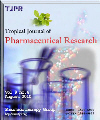
|
Tropical Journal of Pharmaceutical Research
Pharmacotherapy Group, Faculty of Pharmacy, University of Benin, Benin City, Nigeria
ISSN: 1596-5996
EISSN: 1596-5996
Vol. 1, No. 2, 2002, pp. 99-110
|
 Bioline Code: pr02014
Bioline Code: pr02014
Full paper language: English
Document type: Research Article
Document available free of charge
|
|
|
Tropical Journal of Pharmaceutical Research, Vol. 1, No. 2, 2002, pp. 99-110
| en |
Parameters to be Considered in the Simulation of Drug Release from Aspirin Crystals and their Microcapsules
Florence E Eichie and Roland S Okor
Abstract
Purpose: Drug microparticles may be microencapsulated with water-insoluble polymers to obtain controlled release, which may be further determined by the particle distribution. The purpose of this study was to determine the drug release parameters needed for the theoretical prediction of the release profiles of single aspirin crystals and their microcapsules.
Method: Four single crystals of aspirin of varied weight and orthorhombic in shape or their microcapsules also of varied weights were randomly selected for the study. The microcapsules were walled with an acrylatemethacrylate copolymer (wall thickness, 11 ì m). The following parameters were evaluated: the order of release, the dissolution rate constant, k (crystals), the diffusion coefficient, D (microcapsules), the maximum release m∞ and time to attain it t∞. These parameters were in turn used to simulate the release profiles of hypothetical single particles of a wide range size distribution, 0.3 - 1.4 mm at 0.1mm intervals.
Results: The empirical single crystals exhibited an initial zero order (93%; dissolution constant = 4.4 min-1) followed by a first order release (6%; dissolution constant = 0.38 min-1 ). Maximum release from each of the crystals was 99% of the initial particle weight; thus m∞ was a constant fraction of the initial particle weight. A zero order release consistent with a Fickian diffusion model was displayed by the single microcapsules (diffusion coefficient, 5.4x10-4 mm2 min-1). At same particle weight the release parameters m∞, t∞, and the slopes of the rate order plots compared favourably with the theoretical data.
Conclusion: The study indicates that the empirical release data on a few single particles can be used to predict the release profiles of single particles of a wide range of size distribution. This finding may be exploited in the prediction of drug release from polydisperse systems.
Keywords
Aspirin crystals drug release, simulation, microcapsules
|
| |
© Copyright 2002 - Pharmacotherapy Group, Faculty of Pharmacy, University of Benin, Benin City, Nigeria. Also available online at http://www.tjpr.freehosting.net
Alternative site location: http://www.tjpr.org
|
|
